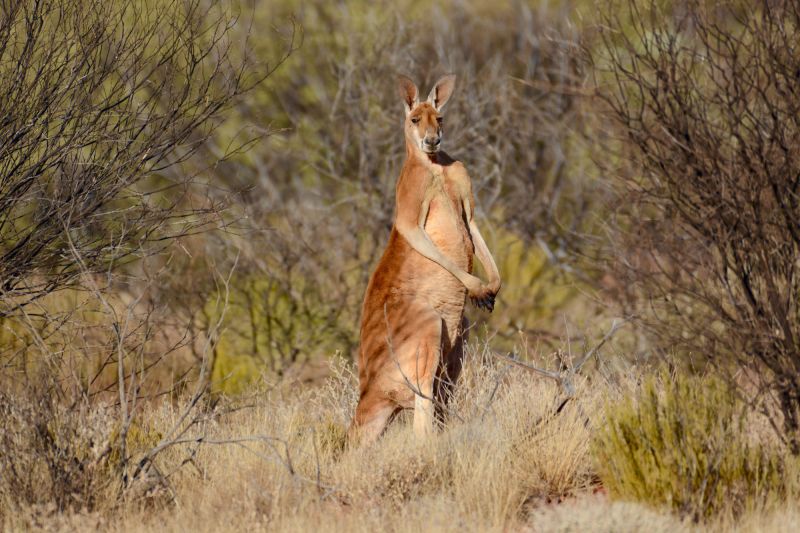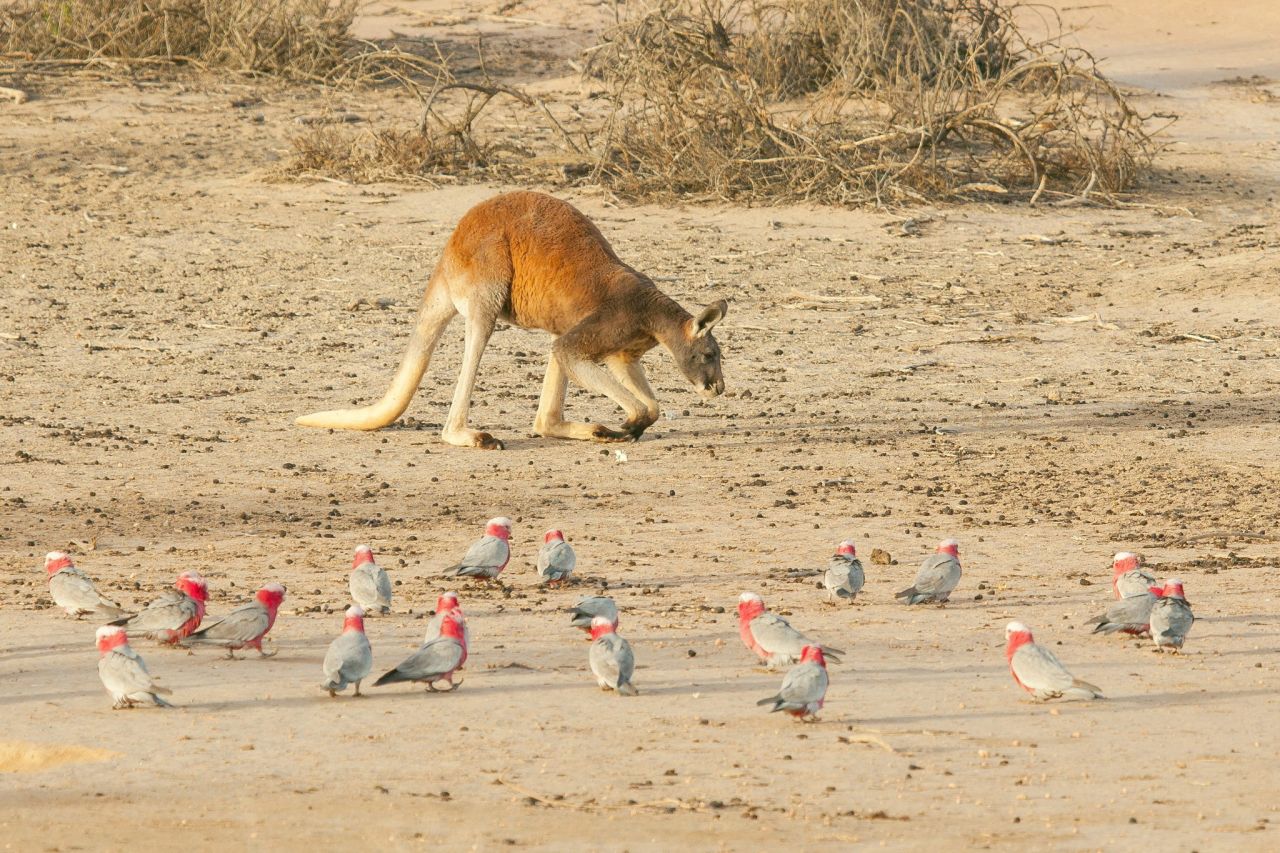The Red Kangaroo (Macropus rufus) is Australia's largest marsupial and an iconic symbol of Australia. Known for their impressive leaps and strong legs, these animals are found across much of Australia's arid and semi-arid interior. It thrives in diverse vegetated habitats, particularly in grasslands and shrublands interspersed with mulga woodlands, where waterholes along creeks provide essential resources.
What is a macropod?
Macropod means 'big foot', and it refers to a family of marsupials known for their large hind legs and feet, which help them hop. This group includes iconic Australian animals like kangaroos, wallabies, and tree kangaroos, ranging from the massive Red Kangaroo to the small Parma Wallaby.
Size and appearance
Male Red Kangaroos can weigh over 90 kg and stand around 1.8 meters tall when upright on their haunches, while females are significantly smaller, generally weighing under 35 kg and reaching about 1.25 meters in height.
They have a unique appearance, with a black marking next to a broad white patch on each side of their muzzle. Their legs, arms, and undersides are off-white, and large males often have a pinkish tint on their chest and throat due to secretions from skin glands. Paws and toes are darker in colour.
Interestingly, although they're called "red" kangaroos, both sexes can be blue-grey, red, or a mix of both—females are often blue-grey, while males are typically reddish.

Red Kangaroo Diet
Red Kangaroos prefer short green grasses but also enjoy herbs and chenopod shrubs like nitre bushes. Like other large kangaroos, they forage primarily in the early morning, evening, and nighttime, avoiding the heat of the day. To stay cool, they crouch or rest in the shade of trees or bushes where they can catch a breeze. While they usually feed in small groups, in open areas with abundant food and water, their gatherings can grow to hundreds of individuals.
Breeding
Red Kangaroos inhabit areas with low, unpredictable rainfall, allowing them to breed almost year-round. Females often mate within hours or days after a joey is born. When conditions are favourable, a female may simultaneously carry an embryo in delayed development, a joey in her pouch, and a young kangaroo at foot still suckling. During prolonged drought, however, she may stop ovulating altogether.

Where to see Red Kangaroos in the wild
Quick fact
Red Kangaroos can cover up to 9 meters in a single bound and travel at speeds of up to 56 km/h!
For an unforgettable experience observing Red Kangaroos, South Australia's Riverland and New South Wales' Mungo National Park are prime locations.
Riverland, South Australia: The Riverland region along the Murray River provides ideal habitats for Red Kangaroos, especially in areas with open grasslands and sparse shrub cover. Guided by Murray River Trails, you can explore this vibrant ecosystem and spot Red Kangaroos in their natural environment, along with other native wildlife.
Mungo National Park, New South Wales: Just across the South Australian border, Echidna Walkabout Nature Tours offers guided excursions through Mungo National Park, known for its striking ancient landscapes and rich Indigenous heritage. The National Park's open plains and semi-arid conditions are ideal for Red Kangaroos, and expert guides can help you spot these iconic animals against the stunning desert backdrop.
Featured Tour: Murray River Safari
Operator: Murray River Trails
Duration: 4 days
Experience the diverse wildlife offerings where Australia's river oasis meets the outback. This multi-activity wildlife safari along Australia's greatest river includes guided walks, canoeing, an outback drive and open back cruising, combined with luxurious houseboat accommodation and superb dining including local wines. Spot Koalas, Red Kangaroos, Western Grey Kangaroos, Australian Pelicans, Royal Spoonbills, Black Swans and Darters from the comfort of a private pontoon cruiser.
Featured Tour: Private Mungo Outback Journey
Operator: Echidna Walkabout Nature Tours
Duration: 4 days
Be captivated by the expansive red sand plains and dunes, riverine ecosystems of the famous Murray and Darling Rivers and the arid land ecosystems around Lake Mungo. Spot Red Kangaroos, Western Grey Kangaroos, Emus, Pink Cockatoos, several parrot species including Mulga, Red-rumped, Mallee Ringnecks and Blue-bonnets, raptor birds including the Wedge-tailed Eagle and several species of lizard basking in the sun.
FAQs
Are Red Kangaroos dangerous to humans?
If visitors keep a respectable distance, Red Kangaroos are not known to be aggressive.
How long do Red Kangaroos live?
In the wild, they typically live 8–12 years.
How do Red Kangaroos regulate their body temperature?
To stay cool, Red Kangaroos will lick their forearms, where blood vessels are close to the skin. As the saliva evaporates, it cools their blood, helping them reduce body temperature. They also rest in shady areas during the hottest parts of the day.

